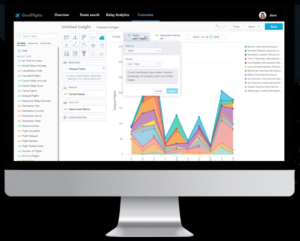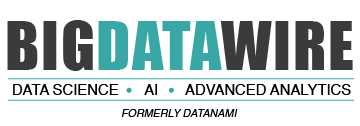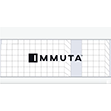

If you’re in the market for an embedded analytics solution, you might want to check out the new “freemium” offering unveiled by GoodData today.
GoodData is one of the leaders in embedded analytics, with over 100,000 organizations using its software and more than 1.6 million individual users around the world. The company primarily sells to software as a service (SaaS) providers that want to include business intelligence capabilities, such as dashboards, reports, and metrics, in their own SaaS offerings.
With the new freemium tier, any organization can embed GoodData’s analytics software in up to five workspaces, which could be the organization’s own customers, franchises, or separate departments and subsidiaries. The freemium offering enables users to build dashboards and reports using a simple drag-and-drop interface, while users can consume analytics via Web and mobile interfaces.
All of GoodData’s software, including the freemium offering, works with cloud-based data warehouses, such as Google BigQuery, Amazon Redshift, and Snowflake (as well as via a simple CSV upload). Each workspace in the freemium tier can hold up to 100MB of data.
The goal of launching the freemium tier is to increase the awareness of GoodData’s embedded analytics software, particularly among smaller firms, says Zdenek “ZD” Svoboda, co-founder and vice president of platform of the company.
“We were focusing primarily on enterprise and large product companies, but we realized that it’s quite interesting to market to smaller companies,” Svoboda says. “So we decided that we could create a free tier of the product, which is essentially marketing for us. It’s not a free trial, so it doesn’t expire. People can use it as long as they’re compliant with the rules of the free tier.”
If GoodData’s customers exceed the terms of the freemium tier (such as by wanting to share it with more than five of their own customers, franchises, or subsidiaries), they can move up to the “growth” tier, which allows users to store up to 1GB per workspace and costs $20 per workspace per month (users are charged extra if they exceed 1GB per workspace). The growth tier also provides more centralized management capabilities, as well as automated provisioning of new workspaces and users, which is lacking in the freemium offering.
Customers can also choose the enterprise version, which adds more tooling, such as 150 data connectors for ETL, better customization of data models, enterprise security and backup, access to GoodData’s cloud-based data warehouse, and the capability to create branded (or white-labeled) dashboards. For each of the three tiers, GoodData supports an unlimited number of users (although the number of distinct organizations using the software is limited to five with the freemium version).
GoodData is betting that it can convert a number of the freemium customers into regular paying customers once they see what its software can do. “Once we get a customer on board, we see pretty fast growth,” Svoboda says. “We are pretty confident that they will outgrow these five workspaces and essentially convert to the growth tier.”
Svoboda says the freemium tier will help GoodData differentiate itself from competitors, specifically Looker and Tableau, which were acquired last year by Google and Salesforce, respectively.
“They have free trials, with an option that expires after a month or three, depending on the competitor,” he says. “Also, they charge on a per-user basis. That makes our pricing seem very attractive for this embedded scenario, since we do not charge per user.”
GoodData built a multi-tenant platform that allows it to ramp up its clients’ analytic environments quickly and affordably, without making extensive modifications, Svoboda says. That’s its main advantage over competitors, he says.
“I think the biggest differentiator is the ability to distribute the analytics to many different organizations and maintain the distributed analytics as a product,” says Svoboda, who works out of GoodData’s office in the Czech Republic. “We have more than 1.6 million users on that platform, so for us it’s very cheap to essentially create another workspace with many users. We are leveraging our cost efficiency.”
GoodData supports an array of cloud data warehouses with its software, which features Web and mobile front-ends. Lately, the company has been building more advanced analytics and machine learning capabilities into its software. GoodData’s customers are using those capabilities to power decision-making in their own applications.
“Many of the decisions that users are doing in their application are backed by analytics,” Svoboda says. “So all the recommendations, such as what they should do as the next step of the process or what they should offer to a customer in CRM or the actions in those products, are all being driven by analytics algorithms, whether it’s ML, recommendation, or other algorithms.”
Related Items:
Avoiding Big IT Outlays with Cloud-Based Analytics
Embedded Analytics Sector Consolidates
Four Mandates to Turn Your Underutilized Data Into Revenue
July 1, 2025
- HighByte Releases Industrial MCP Server for Agentic AI
- Qlik Releases Trust Score for AI in Qlik Talend Cloud
- Dresner Advisory Publishes 2025 Wisdom of Crowds Enterprise Performance Management Market Study
- Precisely Accelerates Location-Aware AI with Model Context Protocol
- MongoDB Announces Commitment to Achieve FedRAMP High and Impact Level 5 Authorizations
June 30, 2025
- Campfire Raises $35 Million Series A Led by Accel to Build the Next-Generation AI-Driven ERP
- Intel Xeon 6 Slashes Power Consumption for Nokia Core Network Customers
- Equal Opportunity Ventures Leads Investment in Manta AI to Redefine the Future of Data Science
- Tracer Protect for ChatGPT to Combat Rising Enterprise Brand Threats from AI Chatbots
June 27, 2025
- EarthDaily Ignites a New Era in Earth Observation with Landmark Satellite Launch
- Domo Deepens Collaboration with Snowflake to Accelerate AI-Driven Analytics and Data Integration on the AI Data Cloud
- AIwire Launches Annual People to Watch Program
June 26, 2025
- Thomson Reuters: Firms with AI Strategies Twice as Likely to See AI-driven Revenue Growth
- DataBahn Raises $17M Series A to Advance AI-Native Data Pipeline Platform
- BCG Report: Companies Must Go Beyond AI Adoption to Realize Its Full Potential
- H2O.ai Breaks New World Record for Most Accurate Agentic AI for Generalized Assistants
- Foresight Raises $5.5M Seed Round to Bring Unified Data and AI to the Private Market
- Treasure Data Launches MCP Server: Let Your LLM Talk to Your Data
- Fujitsu Strengthens Global Consulting with Focus on AI, Data, and Sustainability
- HPE Expands ProLiant Gen12 with New AMD Servers
- Inside the Chargeback System That Made Harvard’s Storage Sustainable
- What Are Reasoning Models and Why You Should Care
- Databricks Takes Top Spot in Gartner DSML Platform Report
- Snowflake Widens Analytics and AI Reach at Summit 25
- Why Snowflake Bought Crunchy Data
- Change to Apache Iceberg Could Streamline Queries, Open Data
- The Evolution of Time-Series Models: AI Leading a New Forecasting Era
- Top-Down or Bottom-Up Data Model Design: Which is Best?
- Agentic AI Orchestration Layer Should be Independent, Dataiku CEO Says
- LinkedIn Introduces Northguard, Its Replacement for Kafka
- More Features…
- Mathematica Helps Crack Zodiac Killer’s Code
- AI Agents To Drive Scientific Discovery Within a Year, Altman Predicts
- Solidigm Celebrates World’s Largest SSD with ‘122 Day’
- ‘The Relational Model Always Wins,’ RelationalAI CEO Says
- Confluent Says ‘Au Revoir’ to Zookeeper with Launch of Confluent Platform 8.0
- DuckLake Makes a Splash in the Lakehouse Stack – But Can It Break Through?
- The Top Five Data Labeling Firms According to Everest Group
- Supabase’s $200M Raise Signals Big Ambitions
- Data Prep Still Dominates Data Scientists’ Time, Survey Finds
- Toloka Expands Data Labeling Service
- More News In Brief…
- Astronomer Unveils New Capabilities in Astro to Streamline Enterprise Data Orchestration
- Astronomer Introduces Astro Observe to Provide Unified Full-Stack Data Orchestration and Observability
- BigID Reports Majority of Enterprises Lack AI Risk Visibility in 2025
- Databricks Unveils Databricks One: A New Way to Bring AI to Every Corner of the Business
- Snowflake Openflow Unlocks Full Data Interoperability, Accelerating Data Movement for AI Innovation
- Seagate Unveils IronWolf Pro 24TB Hard Drive for SMBs and Enterprises
- Gartner Predicts 40% of Generative AI Solutions Will Be Multimodal By 2027
- Databricks Donates Declarative Pipelines to Apache Spark Open Source Project
- Code.org, in Partnership with Amazon, Launches New AI Curriculum for Grades 8-12
- Zscaler Unveils Business Insights with Advanced Analytics for Smarter SaaS Spend and Resource Allocation
- More This Just In…


























